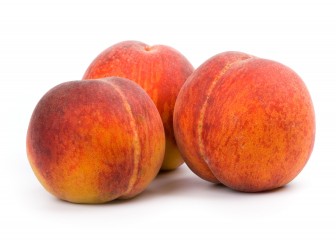Peach Butter
Peaches (at least 8-12)Optional raw honey or pure maple syrup (was sugar)
Lemon juice, if desired
Spices, if desired
Peel and pit the peaches. Quarter them. Put the quartered peaches in a heavy kettle and add about 1-2 cups of water to the pot. Start cooking over low heat to discourage sticking. Cook until tender, stirring often to discourage sticking.
After cooking, drain the peaches through a colander, reserving juice (you can make jelly with the resultant juice). Put the peaches through a food mill to purée. A blender or food processor can be used, though their action is different than milling. I much prefer a food mill -- it strains to purée and separates any extraneous fiber; the fp and blender chop to purée. The final texture is different.
Measure the pulp/purée by volume. Put it into a heavy bottom kettle. Add some sweetener if you wish. Add a wee splash of lemon juice at this point, if you wish. Commence cooking over low to moderate heat, uncovered, stirring to dissolve the sugar. Don't sit down and read the paper. Don't leave the room.
When the stuff begins to boil, reduce the heat to very low, put a splatter screen atop and cook until it is thickened to your liking. *If* you want spiced butter, add spices towards the end of the cooking. I won't give amounts of spices: Start with a small amount. (Duh!) Be careful with ground cloves--a little goes a long way. Spices that are nice with peach butter include cinnamon and nutmeg. If you leave the room to get on with your life, take a timer with you and set it for 5-10 minutes (your cue to run back and stir and check) -- less time as it gets closer to being done.
When you've got the stuff cooking, go back to that reserved juice and strain it, hot, through about 3-4 layers of cheesecloth. Use the juice for peach jelly (check a pectin box for a recipe) or adding it to barbecue sauce.
Fruit butters are great!! They are very interruptable. *If you are uncertain* as to whether or not they are done, hold everything! Get the pot off the heat and let it and the contents cool. Check the texture and consistency then. If it's as you like it, reheat and jar. I've taken three days to make my apricot butter if I haven't had the necessary time in one shot.
Expect the volume to have reduced by about one-third. Use that guide for determining how many canning jars to prepare.
Have your canning jars and lids prepared and ready to fill. When the butter is thickened, fill the jars, remove bubbles, seal and process in a boiling water bath for 10 minutes. Because of the density of fruit butter, I like to have my batch bubbling hot when I fill my jars. I do this by returning the now done butter to my mixing pitcher and nuking it till the edges are bubbling. Then I pour it into the jars, check for bubbles and seal and process.
I recognize that this might be seen as a pretty involved process. It's worth the time.
Other Fruit Butters
Same method.
Apricot Butter - I don't like mine spiced at all! *Maybe* a wee splash of orange juice, more likely not. Do what you will. Easy on the lemon juice if you use it.
Plum Butter - My plums, when puréed, are sour and strong. They can stand cinnamon, clove, and freshly ground allspice. Skip the lemon juice.
Apple Butter - There are a zillion recipes for apple butter. Most include cinnamon, cloves, nutmeg, maybe mace. Skip the lemon juice.
Most fruit butters, because of their tanginess and spiciness are very nice with grilled or roast meats, pork and chicken in particular. Apricot butter is a nice dip for chicken when it's cut with some lemon juice. Plum butter, too.
Adapted from: Barb Schaller, 21 August 1998, via rec.food.preserving
